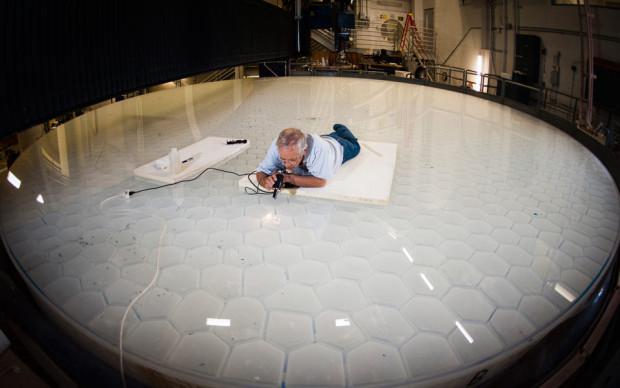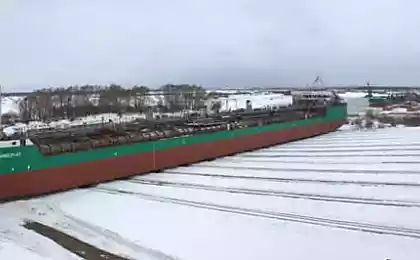592
4 the most scandalous project of modern scientists
They have gone too dalekoEst opinion that the development of technology will ever be the cause of death. And judging by the research projects of recent years, it may happen sooner than we think, in his effort to streamline and improve everything in the world of modern science workers sometimes go too far. Here are a few high-profile and controversial scientific developments, which in the future can be dangerous for mankind.
1. Reanimated deadly virus
In 1918, the "Spanish flu" has claimed about 50 million lives before the immune system mankind has learned to cope with this terrible disease. In October 2005, officers from the US Centers for Disease Control and Prevention removed the virus genome from lung tissue of victims buried in permafrost in Alaska, and took him to one of the laboratories.
Researchers believe that the study of the Spanish flu will help you understand what may be dangerous for human avian influenza virus H5N1, how it can be transmitted to humans. According to Erling Myhre, a specialist in infectious diseases, resuscitation "Spanish flu" is absolutely safe - just one year after removal of the virus, doctors provided the vaccine to protect against it.
However, not all scientists share the optimism of Muret, for example, Jens Kuhn, a virologist at Harvard University, says that might leak as a result of which bioterrorists create on the basis of the genome "Spanish flu" a new deadly disease. In addition, there is a possibility that a vaccine and modern antiviral drugs will be too effective against the disease in 1918, and if the "Spanish flu" in the hands of hackers, is unlikely to avoid casualties.
2. 24-hour den
According to the staff of the National Sleep Foundation, 71% of Americans sleep less than eight hours per day, which negatively affects their psychophysiological state. To save people from the adverse effects of sleep deficit, the scientists have developed a drug CX717, which allows to endure long periods of wakefulness without damage to health.
Specialists from 2006, carried out active drug test, during which part of the test carry exorbitant load, with only four hours of sleep, with no deterioration of their condition is not observed. An enhanced version of CX713 delivers up to 48 hours without sleep, and now has been developing even more effective tool.
"This is just the beginning," - says David Dinges of the University of Pennsylvania researcher who studies the properties of the drug, and Russell Foster of Oxford University supports it: "Perhaps in the future we will be able to provide 24-hour working day».
However, despite the optimistic forecasts, Dinges and Foster do not hurry with conclusions about the undoubted benefits of these drugs. "While we do not know enough about the consequences of a complete renunciation of sleep," - Foster admits, noting that, for example, laboratory rats die after 17 days spent without sleep. Dinges, in turn, is more categorical: "The whole farm is quite effective, but it will never replace us a restful sleep».
3. Ruthless robots ubiytsy
Several years ago, the South Korean company «Samsung Techwin» unveiled a prototype robot fighting SGR-A1, which is able to aim at a distance of about 2, 5 km away, fixing her movement using high-resolution cameras and infrared sensors. SGR-A1 can disarm the enemy using rubber bullets, tear gas and firearms, and to avoid the attack of the robot, you must call the code word (invention Koreans equipped with speech recognition system), which SGR-A1 send a human operator to check, and he has decides to open fire or not.
The South Korean government is spending millions of dollars to develop combat robots to protect the border with the northern neighbor, because the country is experiencing an acute shortage of soldiers.
Now Korean experts are developing a security system that will provide the required level of control of such robots, but many scientists say that the recognition by voice password can not prevent accidents, especially in the early years of martial trials SGR-A1.
4. Planetary light protection schit
In the fight against global warming, Roger Angel, a member of the Mirror Laboratory at the Steward Observatory, put forward the idea that resembles the plot of a science fiction novel. According to the draft, the orbit of the Earth is necessary to deliver special equipment that will reflect approximately 1, 8% of the sunlight.
Roger has made all the necessary mathematical calculations, and now with the financial support of the National Institute of Advanced Concepts Directorate for Aeronautics and Space Administration (NASA), he designs a reflective material that is sent to a stationary orbit.
With such drastic measures, scientists hope to avoid one of the most pessimistic scenarios of the planet, according to which due to rising concentrations of carbon dioxide in the atmosphere, the Earth's temperature can rise to 10 ° C.
via factroom.ru
1. Reanimated deadly virus

In 1918, the "Spanish flu" has claimed about 50 million lives before the immune system mankind has learned to cope with this terrible disease. In October 2005, officers from the US Centers for Disease Control and Prevention removed the virus genome from lung tissue of victims buried in permafrost in Alaska, and took him to one of the laboratories.
Researchers believe that the study of the Spanish flu will help you understand what may be dangerous for human avian influenza virus H5N1, how it can be transmitted to humans. According to Erling Myhre, a specialist in infectious diseases, resuscitation "Spanish flu" is absolutely safe - just one year after removal of the virus, doctors provided the vaccine to protect against it.
However, not all scientists share the optimism of Muret, for example, Jens Kuhn, a virologist at Harvard University, says that might leak as a result of which bioterrorists create on the basis of the genome "Spanish flu" a new deadly disease. In addition, there is a possibility that a vaccine and modern antiviral drugs will be too effective against the disease in 1918, and if the "Spanish flu" in the hands of hackers, is unlikely to avoid casualties.
2. 24-hour den

According to the staff of the National Sleep Foundation, 71% of Americans sleep less than eight hours per day, which negatively affects their psychophysiological state. To save people from the adverse effects of sleep deficit, the scientists have developed a drug CX717, which allows to endure long periods of wakefulness without damage to health.
Specialists from 2006, carried out active drug test, during which part of the test carry exorbitant load, with only four hours of sleep, with no deterioration of their condition is not observed. An enhanced version of CX713 delivers up to 48 hours without sleep, and now has been developing even more effective tool.
"This is just the beginning," - says David Dinges of the University of Pennsylvania researcher who studies the properties of the drug, and Russell Foster of Oxford University supports it: "Perhaps in the future we will be able to provide 24-hour working day».
However, despite the optimistic forecasts, Dinges and Foster do not hurry with conclusions about the undoubted benefits of these drugs. "While we do not know enough about the consequences of a complete renunciation of sleep," - Foster admits, noting that, for example, laboratory rats die after 17 days spent without sleep. Dinges, in turn, is more categorical: "The whole farm is quite effective, but it will never replace us a restful sleep».
3. Ruthless robots ubiytsy

Several years ago, the South Korean company «Samsung Techwin» unveiled a prototype robot fighting SGR-A1, which is able to aim at a distance of about 2, 5 km away, fixing her movement using high-resolution cameras and infrared sensors. SGR-A1 can disarm the enemy using rubber bullets, tear gas and firearms, and to avoid the attack of the robot, you must call the code word (invention Koreans equipped with speech recognition system), which SGR-A1 send a human operator to check, and he has decides to open fire or not.
The South Korean government is spending millions of dollars to develop combat robots to protect the border with the northern neighbor, because the country is experiencing an acute shortage of soldiers.
Now Korean experts are developing a security system that will provide the required level of control of such robots, but many scientists say that the recognition by voice password can not prevent accidents, especially in the early years of martial trials SGR-A1.
4. Planetary light protection schit

In the fight against global warming, Roger Angel, a member of the Mirror Laboratory at the Steward Observatory, put forward the idea that resembles the plot of a science fiction novel. According to the draft, the orbit of the Earth is necessary to deliver special equipment that will reflect approximately 1, 8% of the sunlight.
Roger has made all the necessary mathematical calculations, and now with the financial support of the National Institute of Advanced Concepts Directorate for Aeronautics and Space Administration (NASA), he designs a reflective material that is sent to a stationary orbit.
With such drastic measures, scientists hope to avoid one of the most pessimistic scenarios of the planet, according to which due to rising concentrations of carbon dioxide in the atmosphere, the Earth's temperature can rise to 10 ° C.
via factroom.ru
Scientists from the United States argues that the sore backs and painful labors prove extraterrestrial origin of mankind
The American received a dose of radiation, 60 times higher than normal, and then spent more than 20 years























